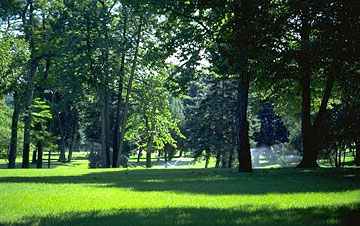Salinity Management Guide

About what's in the water
As a rule, water containing a relatively low amount of salt — i.e., water with an electrical conductivity of less than 0.7 decisiemens per meter, or water with less than 450 milligrams per liter of total dissolved solids — may be used to irrigate most plants without harming them, including salt-sensitive ones. To irrigate with water containing a higher amount of salt, extra management practices may need to be implemented, such as growing mostly or only salt-tolerant plants and irrigating enough to leach salt beyond the roots of plants.
| Parameter | Generally Safe | Slight to Moderate Risk | Severe Risk |
|---|---|---|---|
| Total dissolved solids (TDS) | less than 450 mg/L * | 450 to 2,000 mg/L | more than 2,000 mg/L |
| Electrical conductivity (EC) of water | less than 0.7 dS/m ** | 0.7 to 3.0 dS/m | more than 3.0 dS/m |
Recycled water typically has a slightly higher concentration of salt than does the water from which it originated. (Previous residential or industrial use of the water typically adds 140 to 400 milligrams per liter of salt.) Specifically, recycled water has an electrical conductivity ranging from 0.6 to 1.7 decisiemens per meter. The exceptions are when saline groundwater infiltrates a wastewater system, as can occur in coastal areas, or when brines and other industrial wastes are discharged into wastewater treatment lines.
Most plants will typically suffer injury if sodium exceeds 70 milligrams per liter in water, or 5 percent in plant tissue, or 230 milligrams per liter in soil, in the extract from a saturated soil paste. Plants will usually be injured by chloride if it exceeds 350 milligrams per liter in water, or 1 percent in plant tissue, or 250 milligrams per liter in soil (in an extract). Plants typically will be injured by boron if it exceeds 1 milligram per liter in water, or 200 parts per million in plant tissue, or 5 milligrams per liter in soil (in extract).
| Parameter | Generally Safe | Slight to Moderate Risk | Severe Risk |
|---|---|---|---|
| Sodium, with surface irrigation | SAR * of less than 6 | SAR of 6 to 9 | SAR of more than 9 |
| Sodium, with sprinkler irrigation | less than 70 mg/L ** | more than 70 mg/L | --- |
| Chloride with surface irrigation | less than 140 mg/L | 140 to 300 mg/L | more than 300 mg/L |
| Chloride with sprinkler irrigation | less than 100 mg/L | more than 100 mg/L | --- |
| Boron | less than 0.5 mg/L | 0.5 to 1.0 mg/L | more than 1.0 mg/L |
In general, if a certain water can be used to irrigate plants without harming them, then the recycled water that originates from that water can also be used to irrigate plants without harming them.
| « Previous page | Next page » |